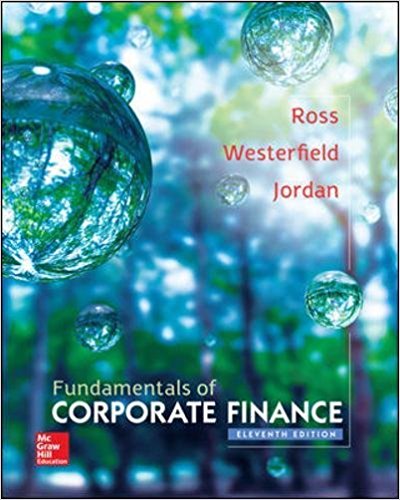This is completed downloadable of Fundamentals of Corporate Finance 11th Edition Ross- Testbank

Product Details:
- ISBN-10 : 0077861701
- ISBN-13 : 978-0077861704
- Author:
The best-selling Fundamentals of Corporate Finance (FCF) has three basic themes that are the central focus of the book:
1) An emphasis on intuition―the authors separate and explain the principles at work on a common sense, intuitive level before launching into any specifics.
2) A unified valuation approach―net present value (NPV) is treated as the basic concept underlying corporate finance.
3) A managerial focus―the authors emphasize the role of the financial manager as decision maker, and they stress the need for managerial input and judgment.
The Eleventh Edition continues the tradition of excellence that has earned Fundamentals of Corporate Finance its status as market leader. McGraw-Hill’s adaptive learning component, LearnSmart, provides assignable modules that help students master chapter core concepts and come to class more prepared. In addition, resources within Connect help students solve financial problems and apply what they’ve learned. Ross Fundamentals’ intuitive approach, managerial focus, and strong end-of-chapter content combine with a complete digital solution to help your students achieve higher outcomes in the course.
Table of Content:
- Part One Introduction
- Chapter 1: Goals and Governance of the Corporation
- 1.1 Investment and Financing Decisions
- The Investment (Capital Budgeting) Decision
- The Financing Decision
- 1.2 What Is a Corporation?
- Other Forms of Business Organization
- 1.3 Who Is the Financial Manager?
- 1.4 Goals of the Corporation
- Shareholders Want Managers to Maximize Market Value
- 1.5 Agency Problems, Executive Compensation, and Corporate Governance
- Executive Compensation
- Corporate Governance
- 1.6 The Ethics of Maximizing Value
- 1.7 Careers in Finance
- 1.8 Preview of Coming Attractions
- 1.9 Snippets of Financial History
- Summary
- Questions and Problems
- Chapter 2: Financial Markets and Institutions
- 2.1 The Importance of Financial Markets and Institutions
- 2.2 The Flow of Savings to Corporations
- The Stock Market
- Other Financial Markets
- Financial Intermediaries
- Financial Institutions
- Total Financing of U.S. Corporations
- 2.3 Functions of Financial Markets and Intermediaries
- Transporting Cash across Time
- Risk Transfer and Diversification
- Liquidity
- The Payment Mechanism
- Information Provided by Financial Markets
- 2.4 The Crisis of 2007–2009
- Summary
- Questions and Problems
- Chapter 3: Accounting and Finance
- 3.1 The Balance Sheet
- Book Values and Market Values
- 3.2 The Income Statement
- Income versus Cash Flow
- 3.3 The Statement of Cash Flows
- Free Cash Flow
- 3.4 Accounting Practice and Malpractice
- 3.5 Taxes
- Corporate Tax
- Personal Tax
- Summary
- Questions and Problems
- Chapter 4: Measuring Corporate Performance
- 4.1 How Financial Ratios Relate to Shareholder Value
- 4.2 Measuring Market Value and Market Value Added
- 4.3 Economic Value Added and Accounting Rates of Return
- Accounting Rates of Return
- Problems with EVA and Accounting Rates of Return
- 4.4 Measuring Efficiency
- 4.5 Analyzing the Return on Assets: The Du Pont System
- The Du Pont System
- 4.6 Measuring Financial Leverage
- Leverage and the Return on Equity
- 4.7 Measuring Liquidity
- 4.8 Interpreting Financial Ratios
- 4.9 The Role of Financial Ratios
- Summary
- Questions and Problems
- Minicase
- Part Two Value
- Chapter 5: The Time Value of Money
- 5.1 Future Values and Compound Interest
- 5.2 Present Values
- Finding the Interest Rate
- 5.3 Multiple Cash Flows
- Future Value of Multiple Cash Flows
- Present Value of Multiple Cash Flows
- 5.4 Reducing the Chore of the Calculations: Part 1
- Using Financial Calculators to Solve Simple Time-Value-of-Money Problems
- Using Spreadsheets to Solve Simple Time-Value-of-Money Problems
- 5.5 Level Cash Flows: Perpetuities and Annuities
- How to Value Perpetuities
- How to Value Annuities
- Future Value of an Annuity
- Annuities Due
- 5.6 Reducing the Chore of the Calculations: Part 2
- Using Financial Calculators to Solve Annuity Problems
- Using Spreadsheets to Solve Annuity Problems
- 5.7 Effective Annual Interest Rates
- 5.8 Inflation and the Time Value of Money
- Real versus Nominal Cash Flows
- Inflation and Interest Rates
- Valuing Real Cash Payments
- Real or Nominal?
- Summary
- Questions and Problems
- Minicase
- Chapter 6: Valuing Bonds
- 6.1 Bond Pricing
- 6.2 Interest Rates and Bond Prices
- Interest Rate Risk and Bond Maturity
- 6.3 Yield to Maturity
- 6.4 Bond Rates of Return
- 6.5 The Yield Curve
- Nominal and Real Rates of Interest
- 6.6 Corporate Bonds and the Risk of Default
- Protecting against Default Risk
- Not All Corporate Bonds Are Plain Vanilla
- Summary
- Questions and Problems
- Chapter 7: Valuing Stocks
- 7.1 Stocks and the Stock Market
- Reading Stock Market Listings
- 7.2 Market Values, Book Values, and Liquidation Values
- 7.3 Valuing Common Stocks
- Valuation by Comparables
- Price and Intrinsic Value
- The Dividend Discount Model
- 7.4 Simplifying the Dividend Discount Model
- Case 1: The Dividend Discount Model with No Growth
- Case 2: The Dividend Discount Model with Constant Growth
- Case 3: The Dividend Discount Model with Nonconstant Growth
- 7.5 Valuing a Business by Discounted Cash Flow
- Valuing the Concatenator Business
- Repurchases and the Dividend Discount Model
- 7.6 There Are No Free Lunches on Wall Street
- Random Walks and Efficient Markets
- 7.7 Market Anomalies and Behavioral Finance
- Market Anomalies
- Bubbles and Market Efficiency
- Behavioral Finance
- Summary
- Questions and Problems
- Minicase
- Chapter 8: Net Present Value and Other Investment Criteria
- 8.1 Net Present Value
- A Comment on Risk and Present Value
- Valuing Long-Lived Projects
- Choosing between Alternative Projects
- 8.2 The Internal Rate of Return Rule
- A Closer Look at the Rate of Return Rule
- Calculating the Rate of Return for Long-Lived Projects
- A Word of Caution
- Some Pitfalls with the Internal Rate of Return Rule
- 8.3 The Profitability Index
- Capital Rationing
- Pitfalls of the Profitability Index
- 8.4 The Payback Rule
- Discounted Payback
- 8.5 More Mutually Exclusive Projects
- Problem 1: The Investment Timing Decision
- Problem 2: The Choice between Long- and Short-Lived Equipment
- Problem 3: When to Replace an Old Machine
- 8.6 A Last Look
- Summary
- Questions and Problems
- Minicase
- Appendix: More on the IRR Rule
- Using the IRR to Choose between Mutually Exclusive Projects
- Using the Modified Internal Rate of Return When There Are Multiple IRRs
- Chapter 9: Using Discounted Cash-Flow Analysis to Make Investment Decisions
- 9.1 Identifying Cash Flows
- Discount Cash Flows, Not Profits
- Discount Incremental Cash Flows
- Discount Nominal Cash Flows by the Nominal Cost of Capital
- Separate Investment and Financing Decisions
- 9.2 Corporate Income Taxes
- 9.3 An Example—Blooper Industries
- Forecasting Blooper’s Cash Flows
- Calculating the NPV of Blooper’s Mine
- Further Notes and Wrinkles Arising from Blooper’s Project
- Summary
- Questions and Problems
- Minicase
- Chapter 10: Project Analysis
- 10.1 The Capital Investment Process, Some Problems, and Some Solutions
- 10.2 Some “What-If” Questions
- Sensitivity Analysis
- Stress Tests and Scenario Analysis
- 10.3 Break-Even Analysis
- Accounting Break-Even Analysis
- NPV Break-Even Analysis
- Operating Leverage
- 10.4 Real Options and the Value of Flexibility
- The Option to Expand
- A Second Real Option: The Option to Abandon
- A Third Real Option: The Timing Option
- A Fourth Real Option: Flexible Production Facilities
- Summary
- Questions and Problems
- Minicase
- Part Three Risk
- Chapter 11: Introduction to Risk, Return, and the Opportunity Cost of Capital
- 11.1 Rates of Return: A Review
- 11.2 A Century of Capital Market History
- Market Indexes
- The Historical Record
- Using Historical Evidence to Estimate Today’s Cost of Capital
- 11.3 Measuring Risk
- Variance and Standard Deviation
- A Note on Calculating Variance
- Measuring the Variation in Stock Returns
- 11.4 Risk and Diversification
- Diversification
- Asset versus Portfolio Risk
- Market Risk versus Specific Risk
- 11.5 Thinking about Risk
- Message 1: Some Risks Look Big and Dangerous but Really Are Diversifiable
- Message 2: Market Risks Are Macro Risks
- Message 3: Risk Can Be Measured
- Summary
- Questions and Problems
- Chapter 12: Risk, Return, and Capital Budgeting
- 12.1 Measuring Market Risk
- Measuring Beta
- Betas for Amazon and McDonald’s
- Total Risk and Market Risk
- 12.2 What Can You Learn from Beta?
- Portfolio Betas
- The Portfolio Beta Determines the Risk of a Diversified Portfolio
- 12.3 Risk and Return
- Why the CAPM Makes Sense
- The Security Market Line
- Using the CAPM to Estimate Expected Returns
- How Well Does the CAPM Work?
- 12.4 The CAPM and the Opportunity Cost of Capital
- The Company Cost of Capital
- What Determines Project Risk?
- Don’t Add Fudge Factors to Discount Rates
- Summary
- Questions and Problems
- Chapter 13: The Weighted-Average Cost of Capital and Company Valuation
- 13.1 Geothermal’s Cost of Capital
- 13.2 The Weighted-Average Cost of Capital
- Calculating Company Cost of Capital as a Weighted Average
- Use Market Weights, Not Book Weights
- Taxes and the Weighted-Average Cost of Capital
- What If There Are Three (or More) Sources of Financing?
- The NPV of Geothermal’s Expansion
- Checking Our Logic
- 13.3 Interpreting the Weighted-Average Cost of Capital
- When You Can and Can’t Use WACC
- Some Common Mistakes
- How Changing Capital Structure Affects Expected Returns
- What Happens When the Corporate Tax Rate Is Not Zero
- 13.4 Practical Problems: Measuring Capital Structure
- 13.5 More Practical Problems: Estimating Expected Returns
- The Expected Return on Bonds
- The Expected Return on Common Stock
- The Expected Return on Preferred Stock
- Adding It All Up
- Real-Company WACCs
- 13.6 Valuing Entire Businesses
- Calculating the Value of the Deconstruction Business
- Summary
- Questions and Problems
- Minicase
- Part Four Financing
- Chapter 14: Introduction to Corporate Financing
- 14.1 Creating Value with Financing Decisions
- 14.2 Patterns of Corporate Financing
- Are Firms Issuing Too Much Debt?
- 14.3 Common Stock
- Stock Splits
- Ownership of the Corporation
- Voting Procedures
- The Wall Street Walk
- Classes of Stock
- 14.4 Preferred Stock
- 14.5 Corporate Debt
- Debt Comes in Many Forms
- Innovation in the Debt Market
- 14.6 Convertible Securities
- Summary
- Questions and Problems
- Chapter 15: How Corporations Raise Venture Capital and Issue Securities
- 15.1 Venture Capital
- Venture Capital Companies
- 15.2 The Initial Public Offering
- Arranging a Public Issue
- Other New-Issue Procedures
- The Underwriters
- 15.3 General Cash Offers by Public Companies
- General Cash Offers and Shelf Registration
- Costs of the General Cash Offer
- Market Reaction to Stock Issues
- 15.4 The Private Placement
- Summary
- Questions and Problems
- Minicase
- Appendix: Hotch Pot’s New-Issue Prospectus
- Part Five Debt and Payout Policy
- Chapter 16: Debt Policy
- 16.1 How Borrowing Affects Value in a Tax-Free Economy
- MM’s Argument—A Simple Example
- How Borrowing Affects Earnings per Share
- How Borrowing Affects Risk and Return
- 16.2 Debt and the Cost of Equity
- No Magic in Financial Leverage
- 16.3 Debt, Taxes, and the Weighted-Average Cost of Capital
- Debt and Taxes at River Cruises
- How Interest Tax Shields Contribute to the Value of Stockholders’ Equity
- Corporate Taxes and the Weighted-Average Cost of Capital
- The Implications of Corporate Taxes for Capital Structure
- 16.4 Costs of Financial Distress
- Bankruptcy Costs
- Costs of Bankruptcy Vary with Type of Asset
- Financial Distress without Bankruptcy
- 16.5 Explaining Financing Choices
- The Trade-Off Theory
- A Pecking Order Theory
- The Two Faces of Financial Slack
- Is There a Theory of Optimal Capital Structure?
- Summary
- Questions and Problems
- Minicase
- Appendix: Bankruptcy Procedures
- Chapter 17: Payout Policy
- 17.1 How Corporations Pay Out Cash to Shareholders
- How Firms Pay Dividends
- Stock Dividends
- Stock Repurchases
- 17.2 The Information Content of Dividends and Repurchases
- 17.3 Dividends or Repurchases? The Payout Controversy
- Dividends or Repurchases? An Example
- Repurchases and the Dividend Discount Model
- Dividends and Share Issues
- 17.4 Why Dividends May Increase Value
- 17.5 Why Dividends May Reduce Value
- Taxation of Dividends and Capital Gains under Current Tax Law
- Taxes and Payout—A Summary
- 17.6 Payout Policy and the Life Cycle of the Firm
- Summary
- Questions and Problems
- Minicase
- Part Six Financial Analysis and Planning
- Chapter 18: Long-Term Financial Planning
- 18.1 What Is Financial Planning?
- Why Build Financial Plans?
- 18.2 Financial Planning Models
- Components of a Financial Planning Model
- 18.3 A Long-Term Financial Planning Model for Dynamic Mattress
- Pitfalls in Model Design
- Choosing a Plan
- Valuing Dynamic Mattress
- 18.4 External Financing and Growth
- Summary
- Questions and Problems
- Minicase
- Chapter 19: Short-Term Financial Planning
- 19.1 Links between Long-Term and Short-Term Financing
- Tax Strategies
- Reasons to Hold Cash
- 19.2 Tracing Changes in Cash
- 19.3 Cash Budgeting
- Preparing the Cash Budget
- 19.4 Dynamic’s Short-Term Financial Plan
- Dynamic Mattress’s Financing Plan
- Evaluating the Plan
- A Note on Short-Term Financial Planning Models
- Summary
- Questions and Problems
- Minicase
- Chapter 20: Working Capital Management
- 20.1 Working Capital
- Components of Working Capital
- Working Capital and the Cash Cycle
- 20.2 Accounts Receivable and Credit Policy
- Terms of Sale
- Credit Agreements
- Credit Analysis
- The Credit Decision
- Collection Policy
- 20.3 Inventory Management
- 20.4 Cash Management
- Check Handling and Float
- Other Payment Systems
- Electronic Funds Transfer
- International Cash Management
- 20.5 Investing Idle Cash: The Money Market
- Money Market Investments
- Calculating the Yield on Money Market Investments
- Yields on Money Market Investments
- The International Money Market
- 20.6 Managing Current Liabilities: Short-Term Debt
- Bank Loans
- Commercial Paper
- Summary
- Questions and Problems
- Minicase
- Part Seven Special Topics
- Chapter 21: Mergers, Acquisitions, and Corporate Control
- 21.1 Types of Mergers
- 21.2 Sensible Motives for Mergers
- Economies of Scale and Scope
- Economies of Vertical Integration
- Complementary Resources
- Changes in Corporate Control
- Industry Consolidation
- Industrial Logic Does Not Guaranty Success
- 21.3 Dubious Reasons for Mergers
- Improved Diversification
- The Bootstrap Game
- Management Bias
- 21.4 The Mechanics of a Merger
- The Form of Acquisition
- Mergers, Antitrust Law, and Popular Opposition
- 21.5 Evaluating Mergers
- Mergers Financed by Cash
- Mergers Financed by Stock
- A Warning
- Another Warning
- 21.6 The Market for Corporate Control
- 21.7 Proxy Contests
- 21.8 Takeovers
- 21.9 Leveraged Buyouts
- Barbarians at the Gate?
- 21.10 Divestitures, Spin-Offs, and Carve-Outs
- 21.11 The Benefits and Costs of Mergers
- Who Gains and Loses from Mergers?
- Buyers versus Sellers
- Mergers and Society
- Summary
- Questions and Problems
- Minicase
- Chapter 22: International Financial Management
- 22.1 Foreign Exchange Markets
- Spot Exchange Rates
- Forward Exchange Rates
- 22.2 Some Basic Relationships
- Exchange Rates and Inflation
- Real and Nominal Exchange Rates
- Inflation and Interest Rates
- The Forward Exchange Rate and the Expected Spot Rate
- Interest Rates and Exchange Rates
- 22.3 Hedging Currency Risk
- Transaction Risk
- Economic Risk
- 22.4 International Capital Budgeting
- Net Present Values for Foreign Investments
- The Cost of Capital for Foreign Investment
- Avoiding Fudge Factors
- Political Risk
- Summary
- Questions and Problems
- Minicase
- Chapter 23: Options
- 23.1 Calls and Puts
- Selling Calls and Puts
- Payoff Diagrams Are Not Profit Diagrams
- Financial Alchemy with Options
- Some More Option Magic
- 23.2 What Determines Option Values?
- Upper and Lower Limits on Option Values
- The Determinants of Option Value
- Option-Valuation Models
- 23.3 Spotting the Option
- Options on Real Assets
- Options on Financial Assets
- Summary
- Questions and Problems
- Chapter 24: Risk Management
- 24.1 Why Hedge?
- 24.2 Reducing Risk with Options
- 24.3 Forward and Futures Contracts
- The Mechanics of Futures Trading
- Commodity and Financial Futures
- Forward Contracts
- 24.4 Valuing Futures and Forward Contracts
- 24.5 Swaps
- Interest Rate Swaps
- Currency Swaps
- 24.6 Innovation in the Derivatives Market
- 24.7 Is “Derivative” a Four-Letter Word?
- Summary
- Questions and Problems
- Part Eight Conclusion
- Chapter 25: What We Do and Do Not Know about Finance
- 25.1 What We Do Know: The Six Most Important Ideas in Finance
- Net Present Value (Chapter 5)
- Risk and Return (Chapters 11 and 12)
- Efficient Capital Markets (Chapter 7)
- MM’s Irrelevance Propositions (Chapters 16 and 17)
- Option Theory (Chapter 23)
- Agency Theory
- 25.2 What We Do Not Know: Nine Unsolved Problems in Finance
- What Determines Project Risk and Present Value?
- Risk and Return—Have We Missed Something?
- Are There Important Exceptions to the Efficient-Market Theory?
- Is Management an Off-Balance-Sheet Liability?
- How Can We Explain Capital Structure?
- How Can We Resolve the Payout Controversy?
- How Can We Explain Merger Waves?
- What Is the Value of Liquidity?
- Why Are Financial Systems Prone to Crisis?
- What Should Be the Goals of the Corporation?
- 25.3 A Final Word
- Questions and Problems
- Appendix A
- Glossary
- Index





